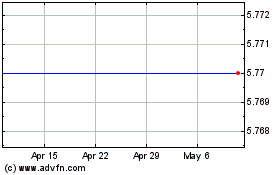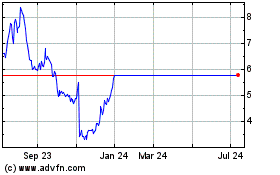FCC's TV Airwaves Auction Drew $19.8 Billion, Led by T-Mobile -- Update
April 13 2017 - 6:21PM
Dow Jones News
By Ryan Knutson, Drew FitzGerald and Shalini Ramachandran
T-Mobile US Inc., Dish Network Corp. and Comcast Corp. were
among the top buyers in the U.S. government's wireless airwaves
auction, which drew $19.8 billion in bids.
The results, announced Thursday, showed that T-Mobile was the
biggest spender at $8 billion. It was followed by Dish, which spent
$6.2 billion, and Comcast with $1.7 billion.
Verizon Communications Inc. and AT&T Inc., the nation's
largest wireless carriers by subscribers, largely sat out the
auction, which was run by the Federal Communications Commission and
began last year. AT&T offered $910 million for the licenses,
while Verizon declined to bid.
Verizon's absence, and the strong showing from companies like
Comcast that don't currently operate cellular networks, is a sign
of the changing telecommunications landscape. Verizon has said it
believes wireless airwaves, known as spectrum, have become too
expensive, and it would rather invest in technology to improve
coverage than buy fresh airwaves.
AT&T said in 2014 that it planned to spend at least $9
billion in the auction, but it recently won a government contract
to build a wireless network for public safety that comes with a
large swath of airwaves. It has also indicated interest in other
sectors like entertainment with its $85 billion deal to acquire
media company Time Warner Inc. An AT&T spokesman declined to
comment on the auction.
It wasn't immediately clear what Comcast and Dish plan to do
with the airwaves. Comcast said earlier this month it would start
selling cellphone service to its home internet customers, and the
service runs off the back of Verizon's network. Dish has been
amassing a trove of wireless airwaves for years that it has yet to
put to use.
The auction's conclusion also means the telecom sector can
resume deal talks after April 27, since participants were
prohibited from such discussions as a safeguard against bidding
collusion. Many analysts think T-Mobile could be an attractive
merger candidate for another wireless carrier like Sprint Corp. or
a cable provider like Comcast.
The complex reverse auction invited television broadcasters to
sell their airwaves with opening prices provided by the government.
Those bids fell until the agency got the licenses it needed at the
lowest possible price. Then, the FCC sold those airwaves to
companies that wanted them for cellular service.
The FCC said more than $10 billion would go to 175 TV stations
that are selling their licenses. Two New Jersey public broadcasting
stations sold licenses for $332 million. WWTO-TV, a Chicago
religious station owned by Trinity Broadcasting Network, went for
$304 million.
Other big sellers were 21st Century Fox, which sold $350 million
of licenses, and Sinclair Broadcast Group Inc., which sold $313
million.
In previous years, spectrum acquisitions have been prudent
investments. In 2006, Comcast was among the cable companies that
bought a chunk of airwaves for $2.37 billion. In 2011, those
companies sold the airwaves to Verizon for $3.6 billion and the
rights to resell Verizon's network under their own brands, which
Comcast is using as the foundation of its new wireless service.
Dish, which spent more than $10 billion in the previous auction
in 2015, must start building its network soon or face FCC
penalties. One option is for it to sell airwaves to, or merge with,
a wireless carrier, which could put the spectrum to use faster. In
February, Dish Chief Executive Charlie Ergen said he expected to
see merger talks pick up after the auction.
Selling the airwaves Dish acquired in this year's auction might
be more complicated, however. The FCC sale included one tier that
could be bought by anyone and a "reserve" tier of low-band airwaves
was set aside for companies that didn't already own a significant
amount of them.
The rule largely prevented AT&T and Verizon from bidding on
the reserve tier and also restricts most sales by the winning
bidders to AT&T or Verizon.
Even though Verizon didn't buy any airwaves, the company said it
was confident in its network position.
The airwaves are particularly important for T-Mobile, which
until recently held almost no low-band frequencies. As a result,
its network has suffered in buildings and rural areas.
AT&T and Verizon have more recently spent billions of
dollars securing rights to higher-frequency airwaves that they hope
will be useful in ultra-fast networks still being developed.
Write to Ryan Knutson at ryan.knutson@wsj.com, Drew FitzGerald
at andrew.fitzgerald@wsj.com and Shalini Ramachandran at
shalini.ramachandran@wsj.com
(END) Dow Jones Newswires
April 13, 2017 18:06 ET (22:06 GMT)
Copyright (c) 2017 Dow Jones & Company, Inc.
DISH Network (NASDAQ:DISH)
Historical Stock Chart
From Mar 2024 to Apr 2024

DISH Network (NASDAQ:DISH)
Historical Stock Chart
From Apr 2023 to Apr 2024
